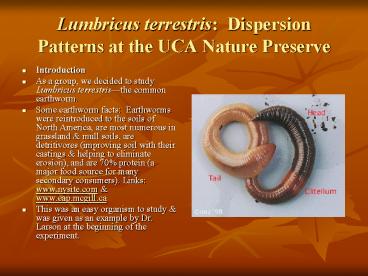Lumbricus terrestris: Dispersion Patterns at the UCA Nature Preserve - PowerPoint PPT Presentation
Title:
Lumbricus terrestris: Dispersion Patterns at the UCA Nature Preserve
Description:
Lumbricus terrestris: Dispersion Patterns at the UCA Nature Preserve Introduction As a group, we decided to study Lumbricus terrestris the common earthworm. – PowerPoint PPT presentation
Number of Views:34
Avg rating:3.0/5.0
Title: Lumbricus terrestris: Dispersion Patterns at the UCA Nature Preserve
1
Lumbricus terrestris Dispersion Patterns at the
UCA Nature Preserve
- Introduction
- As a group, we decided to study Lumbricus
terrestristhe common earthworm. - Some earthworm facts Earthworms were
reintroduced to the soils of North America, are
most numerous in grassland mull soils, are
detritivores (improving soil with their castings
helping to eliminate erosion), and are 70
protein (a major food source for many secondary
consumers). Links www.nysite.com
www.eap.mcgill.ca - This was an easy organism to study was given as
an example by Dr. Larson at the beginning of the
experiment.
2
Methods
- The general hypothesis was suggested by Dr.
Larsondispersion patterns would be random. - Each member of the group chose a random direction
to start each plot of the study. - We decided that the plot size should be 1 ft x 1
ft. - We removed the plant litter from the surface soil
counted the number of worms in each plot. - We recorded the data for thirty random plots.
- Some predictions made during the experiment
worms were believed to be found in wetter soils
and worms were believed to be mating.
3
Results
- In thirty random plots within the ecology site,
we found 36 earthworms. - Average 1.2 individuals per plot
- We expected 9 plots with 0 individuals, but we
found 13 plots. In addition, we found less plots
with 1-3 individuals than expected by the Poison
Probability. - The results depict a contagious dispersion
(compare to Figure 4C.5 in Lab Manual). - Our variance-to-mean ratio suggests random
dispersion with a high tendency toward contagious
dispersion (Figure 4C.6 in Lab Manual).
Number in Plot Observed Frequency Observed Probability Poisson Probability
0 13 0.43 0.301
1 6 0.20 0.361
2 4 0.13 0.217
3 6 0.20 0.087
4 1 0.03 0.026
5 0 0.00 0.006
4
Probabilities of Spatial Distributions
5
Conclusion
- Our study supports the hypothesis that
earthworms are randomly distributed in the soil.
There are several reasons this might be true.
According to Edwards and Lofty in Biology of
Earthworms there are three factors that may
attribute to the random dispersion of earthworms
in the soil. The first is physico-chemical
factors which include soil pH, moisture,
temperature, inorganic salts, aeration, and soil
texture. Edwards and Lofty explain that the only
two of these factors truly important in earthworm
population dispersion are moisture and
temperature. Moisture is important because 90
of an earthworms weight is actually water and
water is directly correlated to earthworm
fecundity. Reproduction rates are better in
wetter environments. Temperature is relevant to
the vertical dispersion of earthworms. At
different times of year earthworms are more
likely to be found in higher or lower levels of
soil. Usually in high heat earthworms are more
likely to be found deeper in the soil (below 7.5
cm). However, recent lower temperatures and
frequent rain may have brought the earthworms
closer to the surface.
6
Conclusion Continued
- A second important factor in
earthworm population dispersion is food
availability. According to Edwards and Lofty
this generally points toward aggregations rather
than random or regular patterns. Due to the
abundance of herbage litter in our plots,
however, it is likely that we found a random
dispersion because all of our plots contained
equal amounts of available food and caused a more
random pattern. The third factor is
reproductive potential and dispersive powers.
Immature earthworms tend to be more aggregated
and adult earthworms tend to be more random. At
times when reproduction is high one would most
likely find aggregations of worms because of the
age of the worms. However, if it is not a
regular mating season or conditions are not right
for mating (such as too high temperatures which
reduces earthworm activity) then the patterns
should be more random because the majority of the
population would be adults.
- A possible hypothesis for the randomness of
the dispersion of the earthworm population in
Jewel E. Moore Nature Reserve could be the
widespread availability of food and unseasonable
wetness and cooler temperatures. Another
possible hypothesis is that the worms were
actually in aggregations due to moisture for
reproduction and unseasonably cool temperatures
and our sample plots were too small and close
together for an accurate depiction of the
dispersion patterns. A third possible
hypothesis is that the earthworms took advantage
of the moisture and coolness a few days prior to
our samples and had the reproductive potential
and dispersive powers to cause the immature worms
to have already moved far enough apart for random
dispersal. - Edwards, C.A., and J.R. Lofty. Biology of
Earthworms. London Chapman and Hall, 1977.































